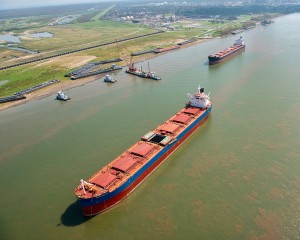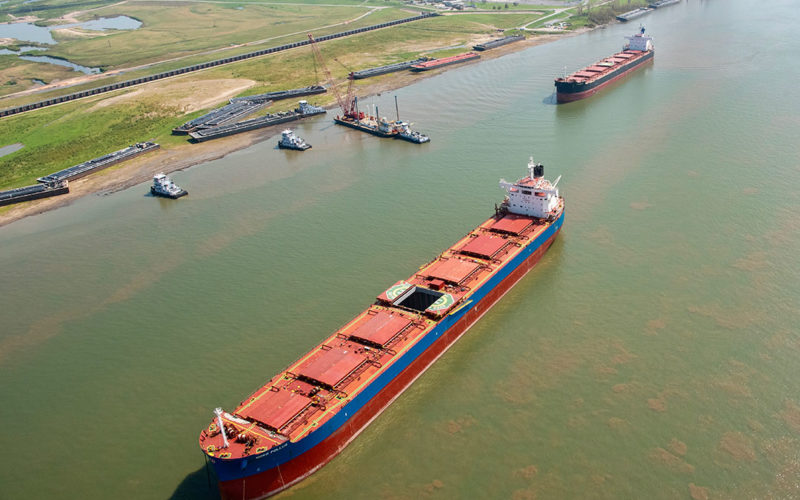
The Gulf Coast is still recovering from Hurricane Ida, which caused significant damage to the maritime and energy infrastructure across south Louisiana.
Ida made landfall on Aug. 29 in Port Fourchon, La., as a Category 4 hurricane. Vessels that rode out the storm in port registered gusts as high as 228 mph, according to Thad Angelloz, a spokesperson for the Greater Lafourche Port Commission, which operates Port Fourchon.
“The damage in the port, while severe, was not catastrophic,” Angelloz said in mid-October. “There are structures that are still intact, and commerce continues to move forward.”
He estimated 75 percent of the port will be fully operational by Oct. 22 but said the remaining 25 percent will take longer. “It is going to be an ongoing recovery for some time.”
Hurricane Ida, already one of the strongest storms in United States history, is projected to be one of the most expensive. Although estimates vary, total damage is projected to approach $100 billion. It also caused power outages to more than 1 million residents and thousands more businesses.
The region’s shipbuilding industry also took a hit. Gulf Island Fabrication in Houma announced Sept. 28 that full operations had resumed — a full month after the storm. Bollinger Shipyards’ facilities in Lockport, Port Fourchon, Larose and Houma also were significantly damaged.
“Our community, like many across south Louisiana, took a direct hit from Hurricane Ida — in many regards, this storm was worse than Katrina,” Ben Bordelon, president and CEO of Bollinger Shipyards, said in a prepared statement.
The region’s offshore energy infrastructure also sustained damage as a result of the storm. As of late September, the Coast Guard had assessed 2,495 reports of pollution, and it was actively supervising mitigation efforts in 312 cases.
The National Oceanic and Atmospheric Administration (NOAA) issued a total of 55 oil spill reports in the two weeks following the hurricane, up from only five in the two weeks preceding the storm.
As of late September, the federal Bureau of Safety and Environmental Enforcement reported workers still hadn’t returned to 32 platforms, and that about 16 percent of the Gulf’s oil production and 24 percent of its gas production remained shut down. Those numbers have since improved.
Shipping activity at the Port of New Orleans resumed within days of the storm, even as much of the city remained without power. Breakbulk cargo operations resumed Sept. 1, and container cargo activities resumed Sept. 7. The port’s terminals and industrial real estate escaped serious damage, according to a port spokeswoman.
Numerous commercial vessels sustained damage during the storm, including towboats and barges that sank or were carried onto dry land. Data on the number of damaged vessels could not be found, although Coast Guard spokesman Jonathan Lally said the number of vessels damaged during Ida was similar to that of other major hurricanes.
A primary focus for federal responders — which include the U.S. Coast Guard, U.S. Army Corps of Engineers and U.S. Navy Supervisor of Salvage and Diving — has been clearing debris from Bayou Lafourche, the Houma Navigation Canal and other nearby waterways. As of late September, 85 obstructions were identified in the Bayou Lafourche channel.
The U.S. Coast Guard additionally reported that 408 navigation aids had been damaged by the storm and that, as of late September, 90 percent of these aids had been repaired.
As bad as conditions were across much of south Louisiana, few places were as badly hit as Lafourche Parish, home to Port Fourchon, Golden Meadow, Galliano and Larose. Angelloz, the port spokesman, said nearly every building in the parish sustained some level of damage.
That includes buildings within the port itself, which directly and indirectly employs thousands of people, many in the oil and gas industry. Power wasn’t fully restored at the port until early October, and water was not back online until Sept. 20 — both of which complicated the recovery.
Even so, some port tenants returned to work nine days after the storm using industrial generators for electricity. The port itself was operational by late September.
“Things are moving and trending in a good direction,” Angelloz said, adding that the resiliency of the port, its tenants and people who work there have contributed to the recovery.
“In south Louisiana, we take these punches and we dust ourselves off and get back to work,” he continued. “We had to get back online because the rest of the country depends on what we do down here.”

